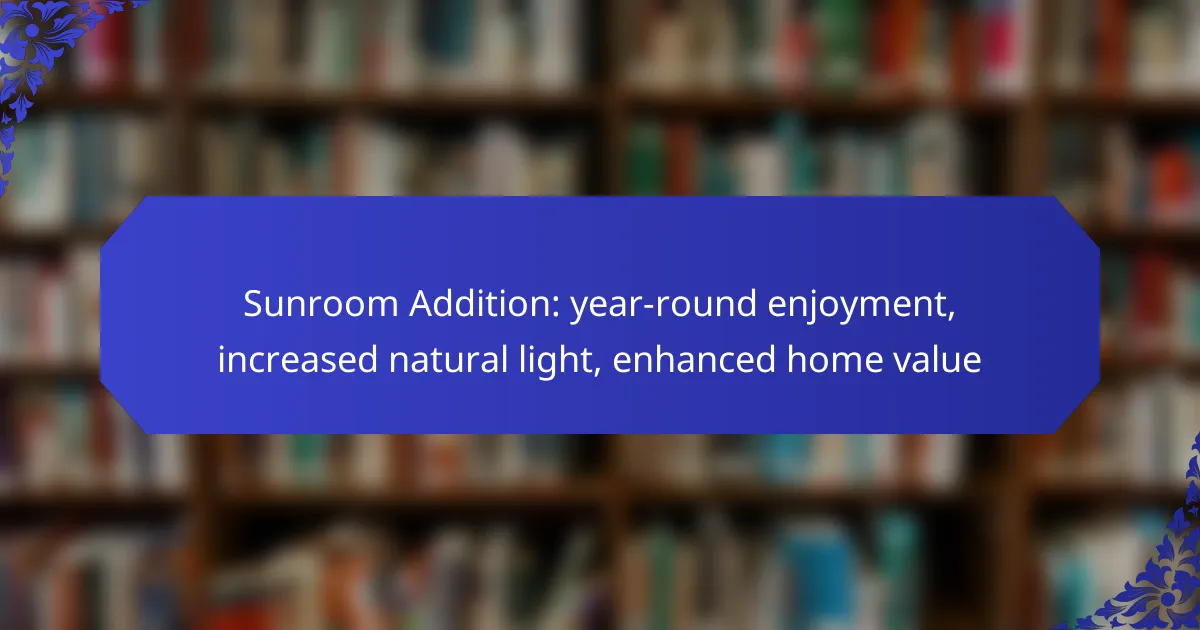A sunroom addition can transform your home by creating a bright and inviting space that you can enjoy all year round. Not only does it increase the amount of natural light in your home, but it also enhances your property’s value and livability, making it a worthwhile investment for any homeowner.

How can a sunroom addition enhance your home in Los Angeles?
A sunroom addition can significantly enhance your home in Los Angeles by providing a bright, inviting space that can be enjoyed throughout the year. This type of addition not only increases natural light but also contributes to your home’s overall value and livability.
Increased natural light
One of the primary benefits of a sunroom is the influx of natural light it brings into your home. With large windows and often a glass ceiling, sunrooms can brighten adjacent rooms and create a more open atmosphere. This can reduce the need for artificial lighting during the day, potentially lowering your energy bills.
In Los Angeles, where sunshine is abundant, a sunroom can be designed to maximize sunlight exposure while minimizing heat gain, making it a comfortable space year-round. Consider using energy-efficient glass to help regulate temperature and reduce glare.
Year-round enjoyment
A sunroom allows for year-round enjoyment of the outdoors without the discomfort of weather extremes. In Los Angeles, you can enjoy the beauty of nature while being sheltered from rain, wind, or excessive heat. This versatility makes it an ideal space for relaxation, entertaining, or even as a home office.
To enhance comfort, consider adding heating and cooling options, such as ceiling fans or portable heaters, to ensure the space remains usable in all seasons. Furnishing the sunroom with comfortable seating and plants can create a tranquil retreat within your home.
Boosted home value
Adding a sunroom can increase your home’s value significantly, appealing to potential buyers who appreciate extra living space and natural light. In Los Angeles, where outdoor living is highly valued, a well-designed sunroom can set your property apart in a competitive market.
When planning your sunroom, focus on quality materials and design that complement your existing home. A sunroom that blends seamlessly with the architecture can yield a return on investment that ranges from 50% to 80%, depending on the quality of the addition and the current real estate market conditions.

What are the key benefits of a sunroom addition?
A sunroom addition offers year-round enjoyment, increased natural light, and enhanced home value. This versatile space can serve multiple purposes while improving the overall aesthetic appeal of your home.
Energy efficiency
Sunrooms can significantly enhance energy efficiency by utilizing passive solar heating. When designed correctly, they can help reduce heating costs during colder months by capturing sunlight and retaining warmth.
Consider using energy-efficient windows and insulation materials to maximize this benefit. Double or triple-glazed windows can minimize heat loss and keep the space comfortable throughout the year.
Versatile living space
A sunroom serves as a flexible living area that can be adapted for various uses, such as a home office, playroom, or relaxation space. This multifunctionality allows homeowners to tailor the room to their specific needs.
When planning your sunroom, think about how you want to use the space. Incorporating features like built-in seating or storage can enhance its usability and make it a more integral part of your home.
Improved aesthetics
Adding a sunroom can significantly boost your home’s curb appeal and overall aesthetic. The abundance of natural light creates a bright, inviting atmosphere that can enhance the beauty of your interior spaces.
To maximize the aesthetic benefits, choose design elements that complement your existing home style. Consider using materials and colors that harmonize with your exterior, ensuring a seamless transition between the sunroom and the rest of your home.

What types of sunrooms are popular in California?
In California, popular sunroom types include three-season sunrooms, four-season sunrooms, and glass solariums. Each type offers unique benefits and considerations, catering to various preferences for year-round use and natural light enhancement.
Three-season sunrooms
Three-season sunrooms are designed for use during spring, summer, and fall, providing a comfortable space to enjoy the outdoors without the full exposure to the elements. They typically feature insulated glass and screens, making them ideal for milder climates like California’s.
When considering a three-season sunroom, think about how you plan to use the space. These sunrooms can be less expensive than four-season options, with costs generally ranging from low tens of thousands to mid-tens of thousands of dollars, depending on size and materials.
Four-season sunrooms
Four-season sunrooms are built to be used year-round, featuring better insulation and climate control systems. This makes them suitable for any season, allowing homeowners to enjoy the space regardless of temperature fluctuations.
Investing in a four-season sunroom can be more costly, often starting in the mid-tens of thousands and going up significantly based on features like heating and cooling systems. Ensure that your local building codes are met, as these structures may require specific permits and adherence to energy efficiency standards.
Glass solariums
Glass solariums are fully enclosed structures made primarily of glass, designed to maximize natural light and provide an unobstructed view of the outdoors. They are often used as greenhouses or relaxation spaces and can significantly enhance the aesthetic appeal of a home.
While glass solariums can be visually stunning, they typically come with a higher price tag, often exceeding the costs of standard sunrooms. Consider factors like UV protection and energy efficiency when planning a glass solarium, as these can impact both comfort and utility bills.

How much does a sunroom addition cost in Los Angeles?
A sunroom addition in Los Angeles typically costs between $20,000 and $70,000, depending on various factors such as size, materials, and design complexity. This investment not only enhances your home’s aesthetic appeal but also increases natural light and overall value.
Average cost range
The average cost range for a sunroom addition in Los Angeles generally falls between $20,000 and $70,000. Basic models may start around the lower end, while more elaborate designs with high-end materials can reach the upper limits. Homeowners should budget for additional expenses like permits and site preparation.
Factors influencing cost
Labor costs in Los Angeles can also vary based on the contractor’s experience and the complexity of the installation. Local building codes and permit fees may add to the total cost, so it’s advisable to consult with local authorities before starting the project.
Financing options
Homeowners in Los Angeles have several financing options for a sunroom addition. Personal loans, home equity lines of credit (HELOC), and cash-out refinancing are popular choices that can help spread out the costs. Each option has its pros and cons, so it’s essential to evaluate your financial situation before deciding.
Additionally, some contractors may offer financing plans or partnerships with lenders, making it easier to manage payments. Always compare interest rates and terms to find the most favorable financing solution for your sunroom project.

What are the zoning regulations for sunroom additions in California?
Zoning regulations for sunroom additions in California vary by city and county, but generally, they require adherence to specific guidelines regarding size, location, and design. Homeowners must check local ordinances to ensure compliance before starting construction.
Permitting requirements
In California, obtaining a permit for a sunroom addition is typically necessary, especially if the structure is attached to the home. Homeowners should submit plans that detail the design, dimensions, and materials to their local building department. Processing times for permits can range from a few weeks to several months, depending on the jurisdiction.
Setback regulations
Setback regulations dictate how far a sunroom must be from property lines. In many California areas, the standard setback can range from 5 to 10 feet from the side and rear property lines. It’s crucial to verify specific local requirements, as some neighborhoods may have stricter rules or additional considerations based on zoning classifications.
HOA considerations
If your property is part of a homeowners association (HOA), you must adhere to their guidelines regarding sunroom additions. HOAs often have rules about the appearance, size, and placement of structures to maintain community aesthetics. Always consult your HOA’s regulations and seek approval before proceeding with any construction plans.

How to choose the right contractor for your sunroom?
Choosing the right contractor for your sunroom is essential for ensuring quality work and satisfaction. Look for professionals with a strong reputation, relevant experience, and a clear understanding of your vision.
Experience and reviews
When selecting a contractor, prioritize those with extensive experience in sunroom additions. Check online reviews and testimonials to gauge customer satisfaction and reliability. Aim for contractors with a history of successful projects and positive feedback from previous clients.
Consider asking for references from past customers to gain insight into their working style and quality of work. A contractor with a solid track record will likely be more adept at handling challenges that may arise during the project.
Portfolio of past projects
A well-rounded portfolio can showcase a contractor’s skills and design capabilities. Review their previous sunroom projects to assess the quality of construction and aesthetics. Look for diversity in styles and sizes to ensure they can accommodate your specific needs.
Request to see before-and-after photos or visit completed projects if possible. This will help you visualize their work and determine if their design approach aligns with your vision for your sunroom addition.
